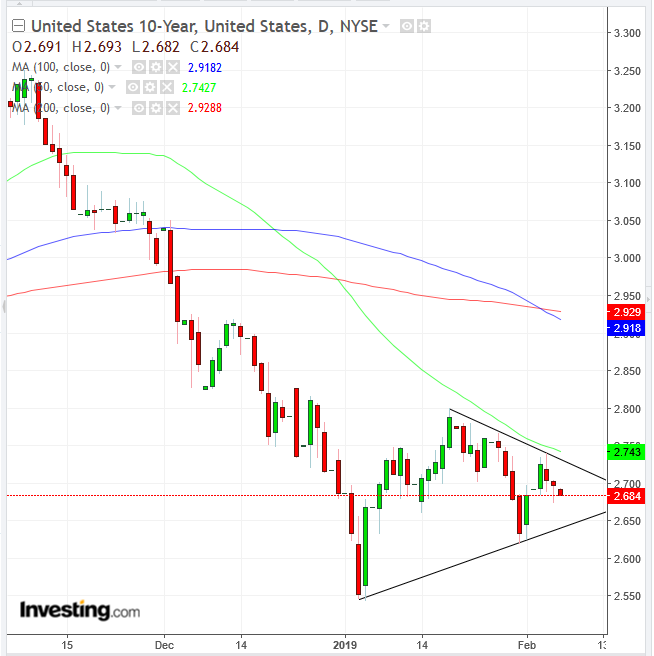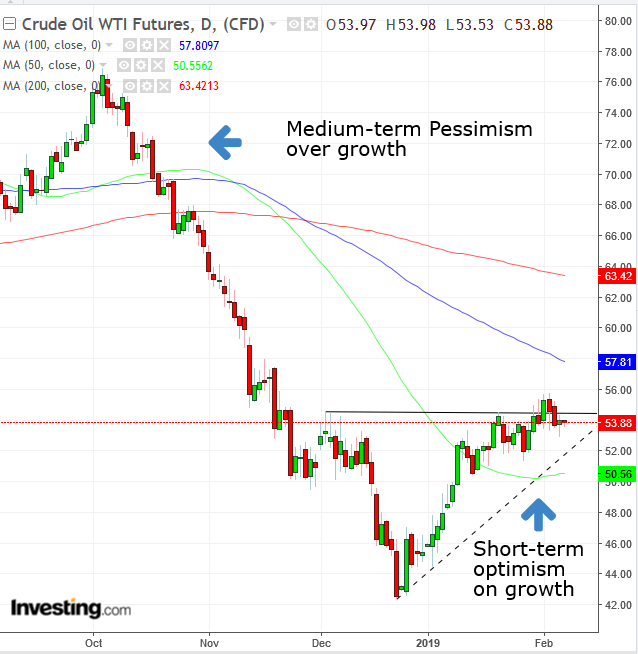- U.S. futures drop as global rally fizzles out
- Financials drag STOXX 600 lower on Societe Generale restructuring plans
- Treasurys, dollar climb as Powell talks up U.S. economy
- Oil slips on surprise inventory and record U.S. production
Key Events
European shares edged lower and futures on the S&P 500, Dow and NASDAQ 100 extended a retreat this morning as the global equity rally lost momentum, partly weighed down by rising demand for U.S. Treasurys.
The STOXX Europe 600 ended a seven-day rally as both automakers and financials stocks sold off. The latter sector took a hit after French investment bank Societe Generale (PA:SOGN) announced it will restructure its business model—trimming down its trading operations and risk-weighted assets—to adjust to tougher capital markets conditions, which also forced the lender to cut its profitability targets through 2020.
Earlier, during the Asian session, the Lunar New Year holiday continued to cause a dearth of signals for traders. Japan’s Nikkei dropped 0.59 percent, pressured by a raft of corporate earnings, though Softbank Group (T:9984) surged 18 percent as it disclosed plans for its biggest-ever buyback.
Global Financial Affairs
On Wednesday, in yet another session characterized by muted volume, U.S. stocks halted a five-day winning streak over a batch of headwinds, including trade uncertainty, global slowdown risks, the looming prospect of another government shutdown and a strengthening dollar.
The S&P 500 (-0.22 percent) in particular fell for the first time in six sessions, with Communication Services (-2.24 percent) as the main laggard. Materials (-0.59 percent) also lagged, despite U.S. President Donald Trump’s restatement that a border security wall will indeed be built up. Meanwhile, Health Care (+0.45 percent) outperformed even as Trump also vowed to tackle high prescription drug prices in his State of the Union address.
Technically, the SPX found resistance beneath the 200 DMA, as its RSI and MACD are set to fall from overbought conditions, triggering sell signals.
We’ve been saying this week that the current market action is not necessarily representative of investor outlook, as volumes stand below their 30-day average.
The Dow Jones Industrial Average (-0.08 percent) outperformed—which is interesting if we consider that a stronger greenback makes multinationals’ exports less competitive in a global market that is already burdened by lingering trade jitters.
The NASDAQ Composite (-0.36 percent) underperformed, as Alphabet (NASDAQ:GOOGL) tumbled 2.52 percent and shares of Electronic Arts (NASDAQ:EA) and Take-Two Interactive Software (NASDAQ:TTWO) plunged by over 13 percent after the two groups posted disappointing earnings results.
Conversely, semiconductor makers ticked higher after Steve Sanghi—the CEO of Microchip Technology's (NASDAQ:MCHP) who famously warned of widespread weakness ahead of the 2008 financial crash and called the 2009 bottom—called for a bottom in the chip cycle.
The Russell 2000 gave up 0.14 percent.

Meanwhile, the yield on 10-year Treasurys slipped lower for a third straight session after Fed Chair Jerome Powell gave a positive assessment of the U.S. economy in his speech yesterday, driving demand for government bonds higher. Powell's latest remarks come as several of the world’s central banks followed the Fed’s dovish turn by putting their tightening plans on hold.
Technically, 10-year yields have been forming a consolidation in the shape of a triangle, as Treasurys have shifted back and forth between buyers and sellers since the beginning of the year. This pattern suggests a downward bias, confirmed by a downside breakout, and the resumption of the underlying downtrend. Such a scenario is expected to further pressure equities.

Powell’s new-found optimism also buoyed the Dollar Index, which was already pushed higher by rising foreign demand for U.S. Treasurys. Technically, the greenback, which climbed for the fifth straight session, bounced off the 200 DMA Jan. 31 and has been gaining ground since, crossing through the 100 and 50 DMAs, aiming to recalibrate with the medium-term uptrend.

In the commodities market, oil edged lower, paring yesterday’s gains, weighed down by the stronger USD and higher U.S. stockpiles, while U.S. supply remains at record levels. While WTI dropped in response to the API report, some analysts are warning that U.S. sanctions on Venezuela have so far been underestimated, and may thereby push prices further down when the market prices in that risk more accurately. In the meantime, oil majors are experiencing a low-growth phase—though companies such as ExxonMobil (NYSE:XOM), which posted upbeat earnings on Friday, may have positioned themselves strategically to be able to achieve longer-term expansion.
Technically, the short-term post-Christmas oil rally, which had been favored by renewed global growth hopes, is being challenged by the medium-term economic pessimism.
From a broader point of view, the recent global rally has mostly stemmed from thin volumes and a lack of fresh catalysts. However, headwinds are still lurching around the corner—namely the lack of any meaningful progress to avert another government shutdown in Washington, which Powell warned would hit confidence and make a long-lasting impact on the country's economic growth. Moreover, U.S.-China trade talks resume in Beijing next week, threatening to reignite market volatility.
Up Ahead
- The Bank of England inflation report will be published today, followed by the BoE interest rate decision and the Boe MPC Meeting Minutes, all of which may have an impact on the politics surrounding Brexit negotiations.
Earnings
- Twitter Inc (NYSE:TWTR) is due to report Thursday before market open, with a $0.16 EPS, up from the $0.1 posted for the corresponding quarter last year. Analysts expect the social media company's ongoing efforts to step up content quality will result in upbeat data.
- Philip Morris (NYSE:PM) will publish corporate results Thursday before market open. EPS is expected to be $1.17, down from 1.27 for the same quarter last year, on $7.39 billion revenues, down from $8.29 billion revenue last year.
- Hasbro (NASDAQ:HAS) is expected to publish its earnings report Friday before market open. Analysts expect an EPS of $1.68, down from last February’s $2.3, and revenues of $1.52 billion, down from $1.716 million for the same quarter last year.
Market Moves
Stocks
- The STOXX Europe 600 fell 0.2 percent as of 8:11 a.m. London time, the first retreat in more than a week.
- Futures on the S&P 500 dropped 0.2 percent, the biggest fall in more than a week.
- The MSCI World Index of developed countries slipped 0.2 percent.
- The MSCI Asia Pacific Index slid 0.3 percent.
Currencies
- The Bloomberg Dollar Spot Index rose 0.3 percent with its sixth straight advance.
- The euro fell 0.1 percent to $1.1349.
- The British pound dropped 0.2 percent to $1.2902, hitting the weakest in more than two weeks with its sixth straight decline.
- The MSCI Emerging Markets Currency Index fell 0.3 percent, reaching the lowest in more than a week.
Bonds
- The yield on 10-year Treasuries slid one basis point to 2.68 percent, the lowest in a week.
- Germany’s 10-year yield fell one basis point to 0.16 percent.
- Britain’s 10-year yield slipped one basis point to 1.204 percent.
Commodities
- Gold fell 0.2 percent to $1,303.65 an ounce.
- West Texas Intermediate crude gave up 0.7 percent to $53.63 a barrel, the lowest in more than a week.
- Natural gas fell 2 percent to $2.61 per mmbtu. A wave of polar vortex seems to has proved too short lived to convince bulls.
- LME copper fell 0.5 percent to $6,249.50 per metric ton.
- Iron ore rose 3.3 percent to 604 yuan per metric ton on its seventh consecutive advance.
